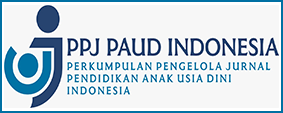
Author
Dian Dian(1), Henie Hikmah Mediani(2
Manajemen Pendidikan Islam, Universitas Islam Negeri Sunan Gunung Djati Bandung, Indonesia(1)
Manajemen Pendidikan Islam, Universitas Islam Negeri Sunan Gunung Djati Bandung, Indonesia(2)
Manajemen Pendidikan Islam, Universitas Islam Negeri Sunan Gunung Djati Bandung, Indonesia(3)
| Article Analytic |
Published : 2022-09-02
Article can trace at:
 Article Metrics
Article Metrics
Abstract Views: 445 times
PDF Downloaded: 210 times
Abstract
Keywords
References
Diana, S., Mafticha, E., & Adiesti, F. (2016). Senam otak meningkatkan prestasi belajar anak usia prasekolah 4-6 Tahun. Jurnal Keperawatan, 9(3), 144–145.
Eliasa, E. I. (2007). Brain Gym, Brain Games (Mari bermain otak dengan senam otak). Makalah Disampaikan Dalam Rangka Program Parent Volunteer Week Di SD Budi Mulia Dua Yogyakarta.
Jalilinasab, S., Saemi, E., & Abedanzadeh, R. (2021). Fundamental motor and social skills of children: The role of Brain Gym exercise. Early Child Development and Care, 1–12. https://doi.org/10.1080/03004430.2021.2003350
Khadijah. (2016). Perkembangan Kognitif Anak Usia Dini. Medan: Perdana Publishing.
Kolber, J., & Nelson, T. (2011). Brain Games. California: Goodbye pictures in association with national.
Maria, I., & Novianti, R. (2020). Efek Penggunaan gadget pada masa pandemi covid-19 terhadap perilaku anak. Aṭfāluna: Journal of Islamic Early Childhood Education, 3(2), 74–81. https://doi.org/10.32505/atfaluna.v3i2.1966
Mariyati, L. I. (2017). Usia dan jenis kelamin dengan kesiapan masuk sekolah dasar. Prosiding Seminar Nasional Psikologi UMG, Halaman, 331–334.
Pranata, L., Fari, A. I., & Indaryati, S. (2021). The Effects of Brain Gym and Coloring Pictures on Cognitive Functions of the Elderly. Media Karya Kesehatan, 4(1).
Prasetyo, W., & Saputra, S. A. (2017). Pengaruh senam otak terhadap daya ingat anak kelas V Sekolah Dasar. Jurnal Keperawatan, 6(1), 36–40. https://doi.org/10.47560/kep.v6i1.157
Santrock, J. W. (2010). Child Development (3rd ed.). New York: McGraw Hill.
Santrock, J. W. (2011). Adolescene : Perkembangan Remaja. Jakarta: Erlangga.
Sugiyono. (2017). Metode Penelitian Kuantutatif, Kualitatif, dan R & D. Bandung: Alfabeta.
Sukri, A., & Purwanti, E. (2016). Meningkatkan hasil belajar siswa melalui brain gym. JEMS: Jurnal Edukasi Matematika Dan Sains, 1(1), 50–57. https://doi.org/10.25273/jems.v1i1.778
Yosef, E. Ben, & Vittorio, L. P. (2016). Word-slam stories as venues for stimulating learning and developing agency with urban high school students. The Qualitative Report, 21(3), 485–494.
Yuniarni, D. (2018). Manfaat Brain Gym bagi Perkembangan Anak Usia Dini di TK Kanisius. Jurnal Buletin Al-Ribaath. https://doi.org/10.29406/br.v15i1.1130
Zulaini, Z. (2017). Manfaat Senam Otak. Jurnal Ilmu Keolahragaan, 15(2), 62–70.
Refbacks
- There are currently no refbacks.

_2022_inPress.png)








